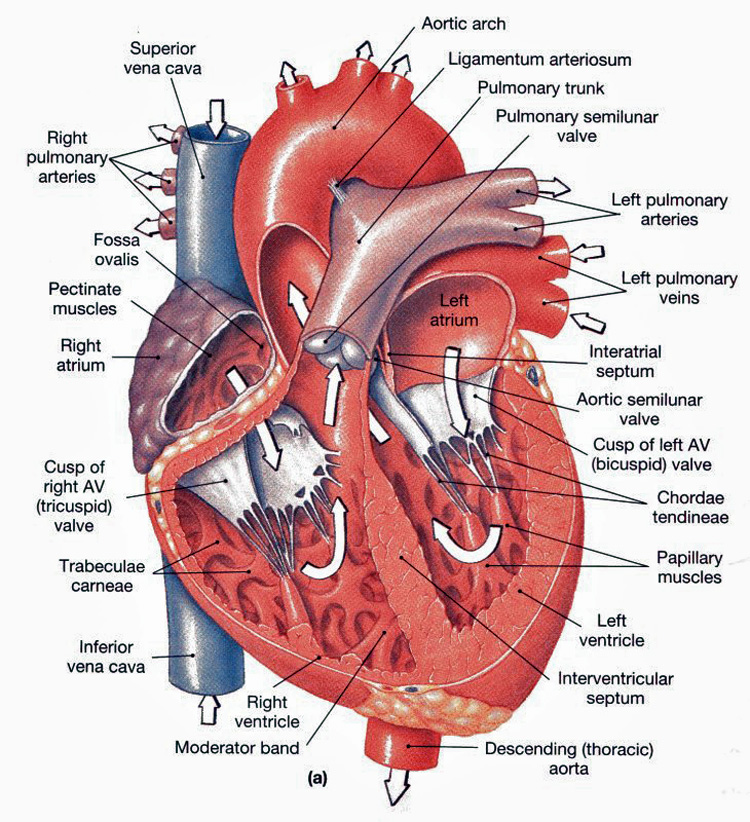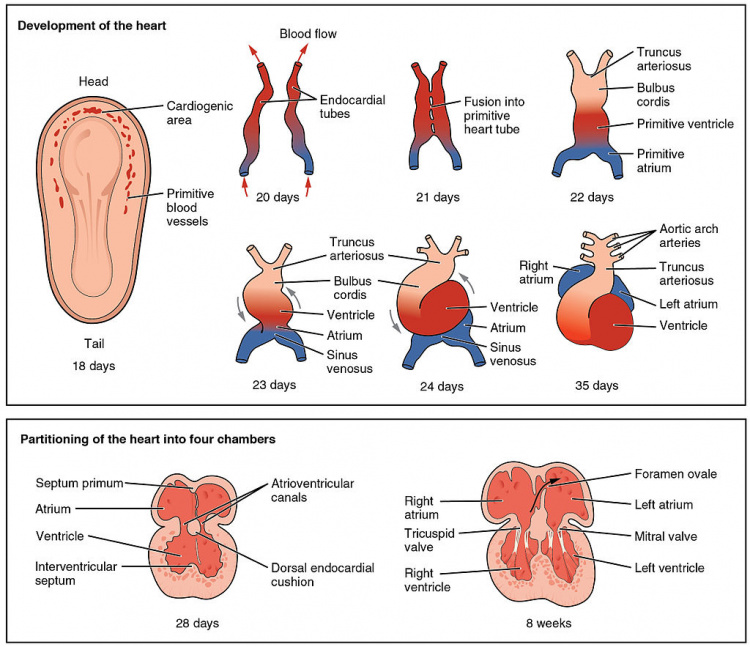2018 Group Project 4: Difference between revisions
| Line 23: | Line 23: | ||
The is heart is considered the hardest working organ in the body. Without the heart functioning the human body would cease to function and carry out everyday tasks. The heart consists of four chambers separated by the septum containing, two atria (right atrium, left atrium), two ventricles (left & right). The right side of the heart contains deoxygenated blood and the left side of the heart contains oxygenated blood. The right atrium collects blood returning from the body (Deoxygenated), the left atrium collects blood (oxygenated) returning from the lungs. The right ventricle pumps blood to the lungs and the left ventricle propels blood into the aorta where blood is dispersed to the rest of the body for consumption. There are four valves located in the heart that prevent the backflow of blood. An average heart rate is anywhere between 60-100 beats per minute. For babies, it can be higher around 120-140 beats per minute, for well-conditioned athletes their heart rates can be below 40 beats per minute. | The is heart is considered the hardest working organ in the body. Without the heart functioning the human body would cease to function and carry out everyday tasks. The heart consists of four chambers separated by the septum containing, two atria (right atrium, left atrium), two ventricles (left & right). The right side of the heart contains deoxygenated blood and the left side of the heart contains oxygenated blood. The right atrium collects blood returning from the body (Deoxygenated), the left atrium collects blood (oxygenated) returning from the lungs. The right ventricle pumps blood to the lungs and the left ventricle propels blood into the aorta where blood is dispersed to the rest of the body for consumption. There are four valves located in the heart that prevent the backflow of blood. An average heart rate is anywhere between 60-100 beats per minute. For babies, it can be higher around 120-140 beats per minute, for well-conditioned athletes their heart rates can be below 40 beats per minute. | ||
Directional flow of blood throughout the body | |||
Inferior and superior vena cava--->Right Atrium--->through Tricuspid valve--->Pulmonary Trunk--->Pulmonary arteries---> | |||
==Embryonic Origins/Embryonic Contributions== | ==Embryonic Origins/Embryonic Contributions== | ||
Revision as of 15:01, 8 September 2018
| Projects 2018: 1 Adrenal Medulla | 3 Melanocytes | 4 Cardiac | 5 Dorsal Root Ganglion |
Project Pages are currently being updated (notice removed when completed)
Neural Crest and Cardiac Development
Introduction of the heart
The heart is a muscular organ which plays a critical role in the circulatory system by mechanically pumping blood to various organs around the body for the exchange of nutrients and gases. It is located at the center of the chest, right behind the sternum and is tilted slightly to the left. The heart has four different chambers which are compartmentalized by semilunar and atrioventricular valves into the left and right atria and ventricles
Cardiac neural crest cells
Neural crest cells are a population of multipotent cells which arises during embryonic development at the dorsal neural tube. These cells are capable of migrating and differentiating throughout the body to give rise to many different cell types. The cardiac neural crest cells (CNCCs) are a subpopulation of the cranial neural crest cells and migrate ventrally from the dorsal neural tube and accumulate in the circumpharyngeal ridge. PubmedParser error: Invalid PMID, please check. (PMID: [1]) The cardiac neural crest wells will then proceed into the pharyngeal arches as each arch develops.
CNCCs are not critical in the initial formation of vessels but they are needed for the remodelling of subsequent arteries, and will give rise to the smooth muscle tunics of the great arteries.PubmedParser error: Invalid PMID, please check. (PMID: [2])
History of cardiac neural crest cells
CNCC was first discovered in a study carried out on chicks by Kirby et al., (1983), where it was discovered that by ablating a region of neural crest cells, embryos lacked aorticopulmonary septation. The subregion of cranial neural crest ablated by Dr. Kirby is now known as the “cardiac neural crest”, not because the cells of this region are dedicated to migrating to the heart, but rather for their importance in crest-derived ectomesenchyme of cardiovascular development. [1]
structure of the cardiovascular network/histology/anatomy/physiology
Copyright
http://baldaivirtuves.info/copyright/
The is heart is considered the hardest working organ in the body. Without the heart functioning the human body would cease to function and carry out everyday tasks. The heart consists of four chambers separated by the septum containing, two atria (right atrium, left atrium), two ventricles (left & right). The right side of the heart contains deoxygenated blood and the left side of the heart contains oxygenated blood. The right atrium collects blood returning from the body (Deoxygenated), the left atrium collects blood (oxygenated) returning from the lungs. The right ventricle pumps blood to the lungs and the left ventricle propels blood into the aorta where blood is dispersed to the rest of the body for consumption. There are four valves located in the heart that prevent the backflow of blood. An average heart rate is anywhere between 60-100 beats per minute. For babies, it can be higher around 120-140 beats per minute, for well-conditioned athletes their heart rates can be below 40 beats per minute.
Directional flow of blood throughout the body
Inferior and superior vena cava--->Right Atrium--->through Tricuspid valve--->Pulmonary Trunk--->Pulmonary arteries--->

